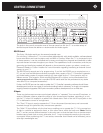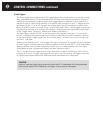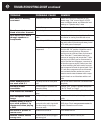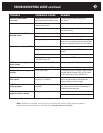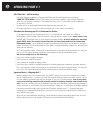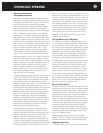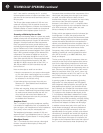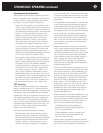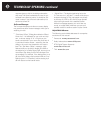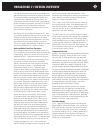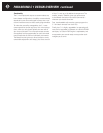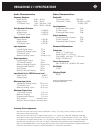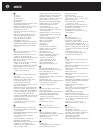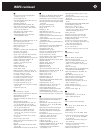
TECHNICALLY SPEAKING continued
61
Using Unmatched Power Amplifiers:
While it’s best to use identical amplifiers for all chan-
nels, it’s sometimes more convenient or economical
to use a mixture of amps, especially if you already
have some. If you do, observe the following:
•
Check with your amplifiers’ manufacturers to see
which of your amplifiers do and do not reverse sig-
nal polarity. Then reverse the output connections of
the amplifiers that reverse polarity – and only those
amps (i.e., connect their black terminals to the
speakers’ red terminals, and vice versa). This will
ensure correctly matched polarity from all your
speakers. Otherwise, “imaging” (the sense of
where sounds are coming from in the recorded
soundfield) will be vague, and bass may suffer.
•
It is not necessary that your amplifiers have identi-
cal input sensitivity (a measure of the input level
needed for a given output power), because any
variations are automatically compensated for when
you set up and match your speaker levels.
•
Your amplifiers need not have the same power rat-
ings, either. Low bass requires the most amplifier
power to reach adequate levels for music and spe-
cial effects. So your most powerful amplifiers
should be used for your subwoofers (if they have
no amplifiers of their own) and for speakers that
you identify as “Large” during C 1 setup. If you
have “Large” speakers in all channels, the front
speakers should get the most power, then the sur-
round speakers, and the lowest-powered amps can
be used for the surround back channels. If you
have a mix of “Large” and “Small” speakers, use
the more powerful amps for the “Large” ones.
THX
®
Processing
When THX modes are selected for an incompatible
source or speaker setup, the C 1 will remember the
selection and will automatically apply it when the setup
is changed or when a compatible source is selected.
Pressing the THX key on the Master remote turns on
THX signal enhancements that work in conjunction
with most of the C 1 listening modes. (The excep-
tions are those which generate surround signals from
two-channel source material, such as Pro Logic, PL II
Movie, PL II Music, Neo:6 Cinema, Neo: 6 Music,
Natural, Party, Club, and Concert.)
THX processing has several parts and modes:
•
Re-Equalization, which is patented by Lucasfilm,
adjusts the frequency response of movie sound-
tracks to compensate for the acoustical differences
between home theaters and commercial movie
theaters; without it, movie soundtracks would
sound overly bright and fatiguing. It is applied to
the front channels and, in THX Surround EX mode,
to the surround back channels, but not to the side
surrounds. Re-Equalization is not used in the THX
MusicMode.
•
Timbre Matching compensates for a characteristic
of the human hearing that changes the apparent
frequency balance for identical sounds coming
from different angles and directions. Because the
main speakers are at the front and surround speak-
ers are at the sides, this hearing characteristic
would make voices and other sounds change as
they moved from the front to the surround chan-
nels, or vice versa. Timbre matching alters the fre-
quency balance in the side surround channels to
compensate for this.
•
Adaptive Decorrelation functions with Dolby Pro
Logic to add a greater sense of spaciousness and
to enlarge the listening “Sweet spot.” It accom-
plishes this by altering the mono surround informa-
tion so that the left and right surround speakers
receive different, rather than identical, signals. It
does not apply when the surround channels
already differ from each other, as is usually the
case with such discrete digital surround systems
as Dolby Digital and DTS.
•
THX Surround EX decodes information for the sur-
round back channels from signals matrixed into the
surround side channels. It is not available for non-
surround signals or for those which, like DTS-ES
Discrete, carry back surround information as a sep-
arate digital signal. To activate THX Surround EX,
press the THX key on the Master remote while in
Direct mode. (If “THX EX Enable” on the “THX
Audio setup” menu is not set to “EX On,” you will
have to push the THX key twice.) This mode is
available only when the presence of at least one
surround back speaker has been noted on the
Speaker Setup/Size menu.
•
Advanced Speaker Array (ASA), available only in sys-
tems with dual surround back speakers, compen-
sates for the effect of different speaker spacings on
the size of the listening “sweet spot.” When it is
active, two more modes become available:
– THX Advanced Cinema is designed for
playback of 5.1-channel digital soundtracks
over a 7.1-channel system.
– THX MusicMode is similar, but sends more
sound to the surround back speakers and
less to the side surrounds.
•
Boundary Gain Compensation reduces excessive
bass below about 35 Hz, to prevent the boominess
that can occur when speakers with substantial



